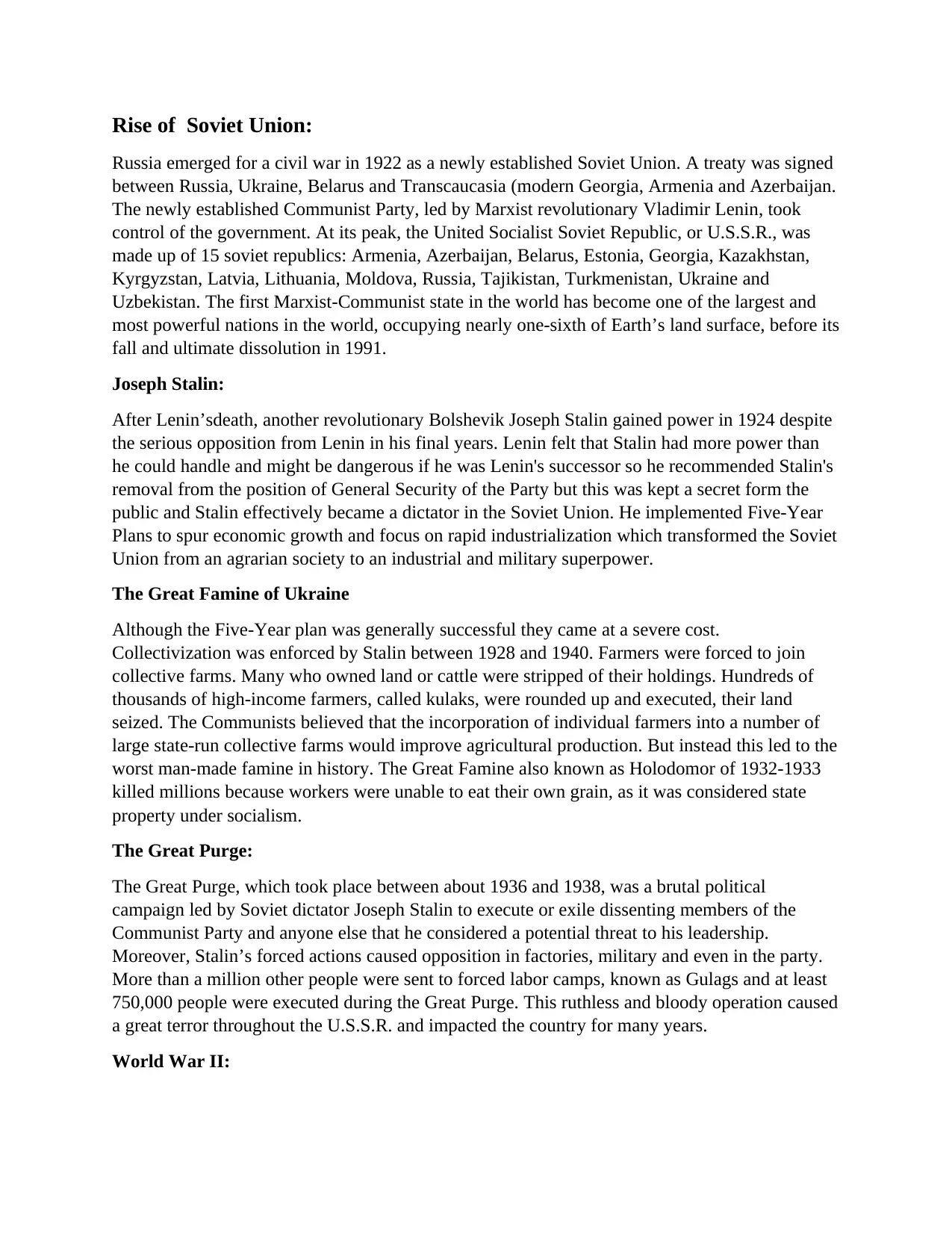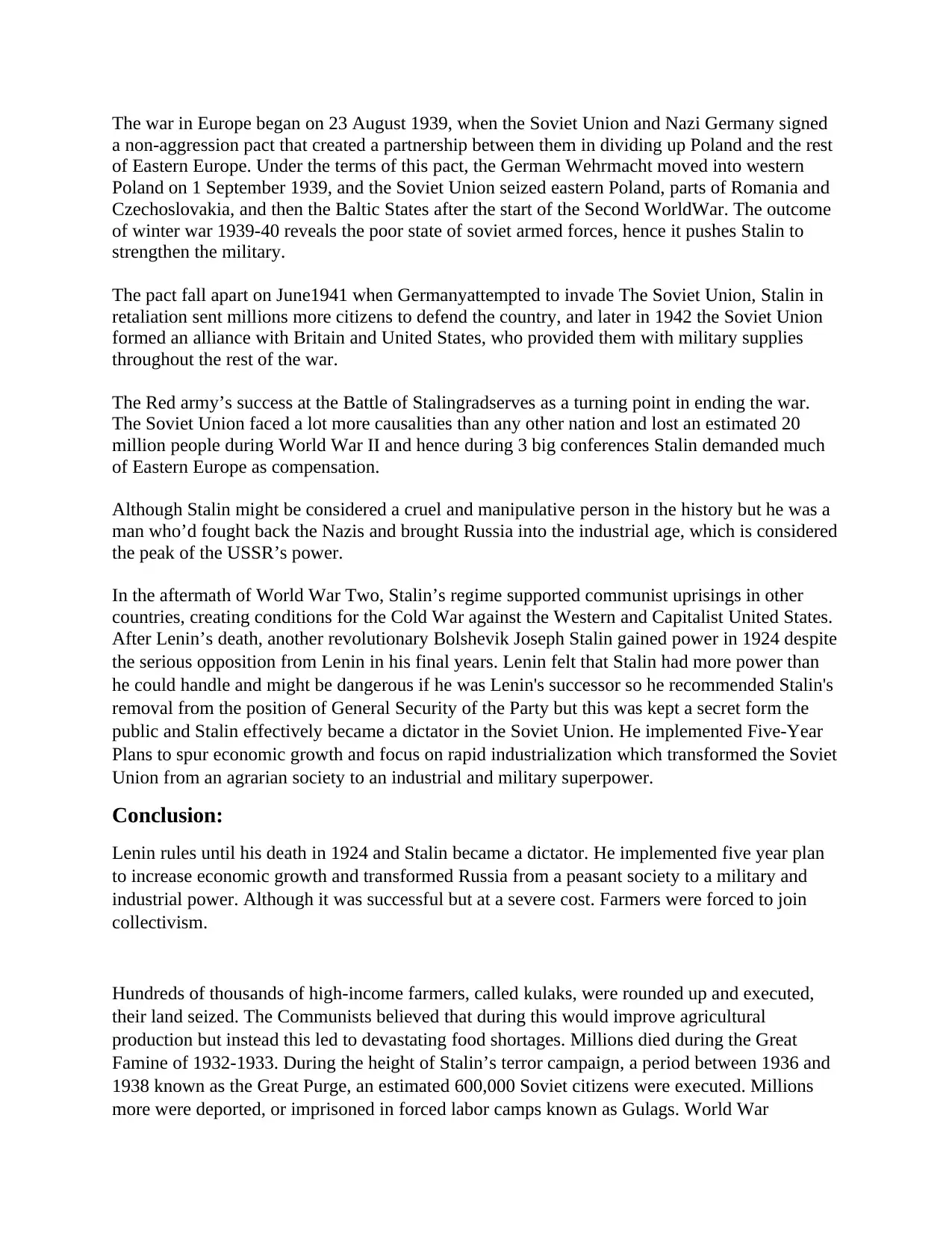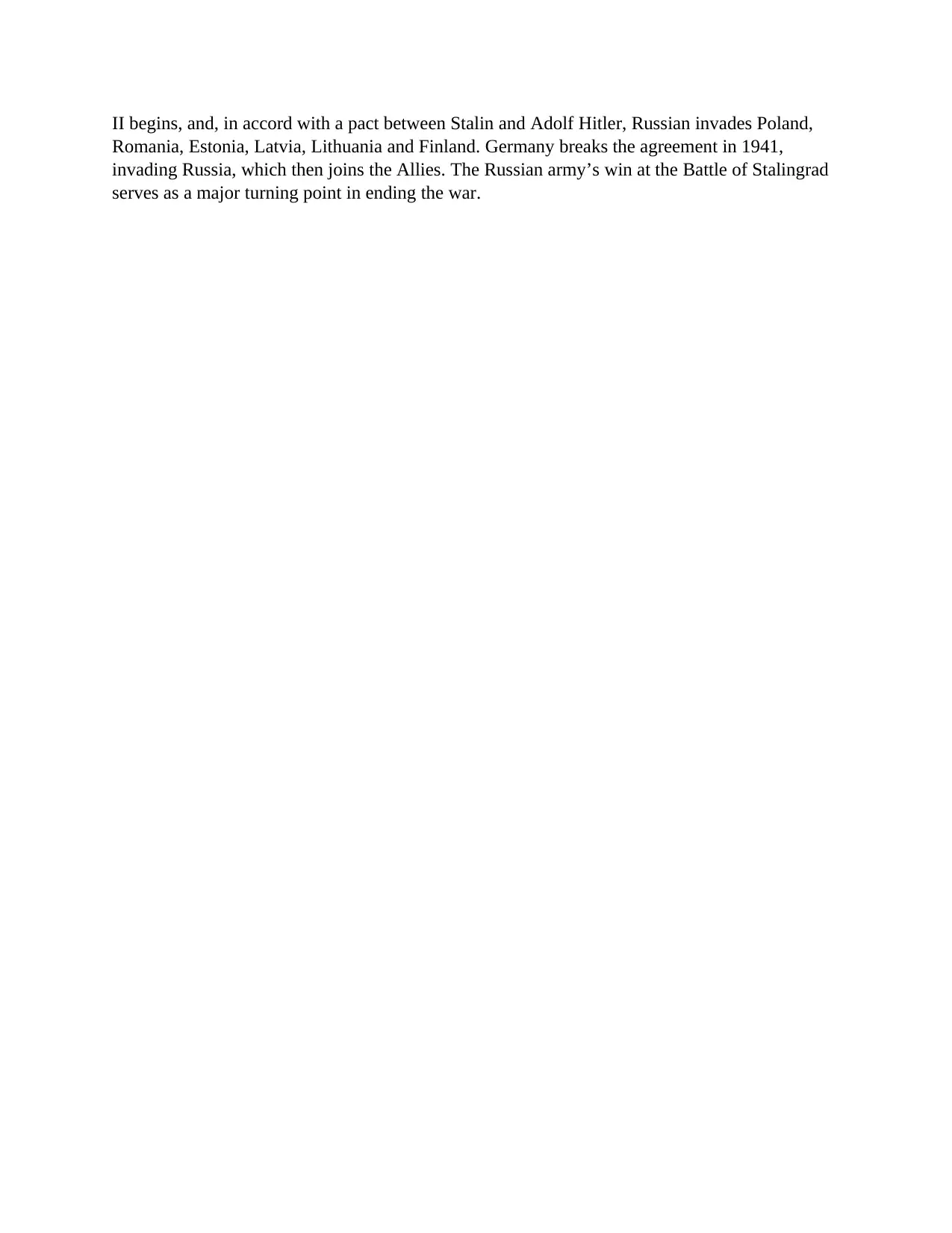Analyzing the Rise and Fall of the Soviet Union: A Historical Essay
VerifiedAdded on 2023/02/01
|3
|1146
|73
Essay
AI Summary
This essay provides a comprehensive overview of the history of the Soviet Union, beginning with its formation in 1922 after the Russian Civil War and the signing of a treaty between Russia, Ukraine, Belarus, and Transcaucasia. It details the establishment of the Communist Party under Vladimir Lenin and the subsequent rise of Joseph Stalin to power after Lenin's death. The essay examines Stalin's implementation of the Five-Year Plans, which transformed the Soviet Union into an industrial and military superpower, albeit at a significant cost, including the forced collectivization of farms that led to the Great Famine of Ukraine (Holodomor). It explores the Great Purge, a period of political repression and executions. The essay further discusses the Soviet Union's involvement in World War II, its alliance with the Allies, and the Red Army's crucial role in the war's conclusion. The conclusion summarizes the key events and the lasting impact of the Soviet Union on global politics and history. The provided information is sourced from a student's work to be published on Desklib.

Rise of Soviet Union:
Russia emerged for a civil war in 1922 as a newly established Soviet Union. A treaty was signed
between Russia, Ukraine, Belarus and Transcaucasia (modern Georgia, Armenia and Azerbaijan.
The newly established Communist Party, led by Marxist revolutionary Vladimir Lenin, took
control of the government. At its peak, the United Socialist Soviet Republic, or U.S.S.R., was
made up of 15 soviet republics: Armenia, Azerbaijan, Belarus, Estonia, Georgia, Kazakhstan,
Kyrgyzstan, Latvia, Lithuania, Moldova, Russia, Tajikistan, Turkmenistan, Ukraine and
Uzbekistan. The first Marxist-Communist state in the world has become one of the largest and
most powerful nations in the world, occupying nearly one-sixth of Earth’s land surface, before its
fall and ultimate dissolution in 1991.
Joseph Stalin:
After Lenin’sdeath, another revolutionary Bolshevik Joseph Stalin gained power in 1924 despite
the serious opposition from Lenin in his final years. Lenin felt that Stalin had more power than
he could handle and might be dangerous if he was Lenin's successor so he recommended Stalin's
removal from the position of General Security of the Party but this was kept a secret form the
public and Stalin effectively became a dictator in the Soviet Union. He implemented Five-Year
Plans to spur economic growth and focus on rapid industrialization which transformed the Soviet
Union from an agrarian society to an industrial and military superpower.
The Great Famine of Ukraine
Although the Five-Year plan was generally successful they came at a severe cost.
Collectivization was enforced by Stalin between 1928 and 1940. Farmers were forced to join
collective farms. Many who owned land or cattle were stripped of their holdings. Hundreds of
thousands of high-income farmers, called kulaks, were rounded up and executed, their land
seized. The Communists believed that the incorporation of individual farmers into a number of
large state-run collective farms would improve agricultural production. But instead this led to the
worst man-made famine in history. The Great Famine also known as Holodomor of 1932-1933
killed millions because workers were unable to eat their own grain, as it was considered state
property under socialism.
The Great Purge:
The Great Purge, which took place between about 1936 and 1938, was a brutal political
campaign led by Soviet dictator Joseph Stalin to execute or exile dissenting members of the
Communist Party and anyone else that he considered a potential threat to his leadership.
Moreover, Stalin’s forced actions caused opposition in factories, military and even in the party.
More than a million other people were sent to forced labor camps, known as Gulags and at least
750,000 people were executed during the Great Purge. This ruthless and bloody operation caused
a great terror throughout the U.S.S.R. and impacted the country for many years.
World War II:
Russia emerged for a civil war in 1922 as a newly established Soviet Union. A treaty was signed
between Russia, Ukraine, Belarus and Transcaucasia (modern Georgia, Armenia and Azerbaijan.
The newly established Communist Party, led by Marxist revolutionary Vladimir Lenin, took
control of the government. At its peak, the United Socialist Soviet Republic, or U.S.S.R., was
made up of 15 soviet republics: Armenia, Azerbaijan, Belarus, Estonia, Georgia, Kazakhstan,
Kyrgyzstan, Latvia, Lithuania, Moldova, Russia, Tajikistan, Turkmenistan, Ukraine and
Uzbekistan. The first Marxist-Communist state in the world has become one of the largest and
most powerful nations in the world, occupying nearly one-sixth of Earth’s land surface, before its
fall and ultimate dissolution in 1991.
Joseph Stalin:
After Lenin’sdeath, another revolutionary Bolshevik Joseph Stalin gained power in 1924 despite
the serious opposition from Lenin in his final years. Lenin felt that Stalin had more power than
he could handle and might be dangerous if he was Lenin's successor so he recommended Stalin's
removal from the position of General Security of the Party but this was kept a secret form the
public and Stalin effectively became a dictator in the Soviet Union. He implemented Five-Year
Plans to spur economic growth and focus on rapid industrialization which transformed the Soviet
Union from an agrarian society to an industrial and military superpower.
The Great Famine of Ukraine
Although the Five-Year plan was generally successful they came at a severe cost.
Collectivization was enforced by Stalin between 1928 and 1940. Farmers were forced to join
collective farms. Many who owned land or cattle were stripped of their holdings. Hundreds of
thousands of high-income farmers, called kulaks, were rounded up and executed, their land
seized. The Communists believed that the incorporation of individual farmers into a number of
large state-run collective farms would improve agricultural production. But instead this led to the
worst man-made famine in history. The Great Famine also known as Holodomor of 1932-1933
killed millions because workers were unable to eat their own grain, as it was considered state
property under socialism.
The Great Purge:
The Great Purge, which took place between about 1936 and 1938, was a brutal political
campaign led by Soviet dictator Joseph Stalin to execute or exile dissenting members of the
Communist Party and anyone else that he considered a potential threat to his leadership.
Moreover, Stalin’s forced actions caused opposition in factories, military and even in the party.
More than a million other people were sent to forced labor camps, known as Gulags and at least
750,000 people were executed during the Great Purge. This ruthless and bloody operation caused
a great terror throughout the U.S.S.R. and impacted the country for many years.
World War II:
Paraphrase This Document
Need a fresh take? Get an instant paraphrase of this document with our AI Paraphraser

The war in Europe began on 23 August 1939, when the Soviet Union and Nazi Germany signed
a non-aggression pact that created a partnership between them in dividing up Poland and the rest
of Eastern Europe. Under the terms of this pact, the German Wehrmacht moved into western
Poland on 1 September 1939, and the Soviet Union seized eastern Poland, parts of Romania and
Czechoslovakia, and then the Baltic States after the start of the Second WorldWar. The outcome
of winter war 1939-40 reveals the poor state of soviet armed forces, hence it pushes Stalin to
strengthen the military.
The pact fall apart on June1941 when Germanyattempted to invade The Soviet Union, Stalin in
retaliation sent millions more citizens to defend the country, and later in 1942 the Soviet Union
formed an alliance with Britain and United States, who provided them with military supplies
throughout the rest of the war.
The Red army’s success at the Battle of Stalingradserves as a turning point in ending the war.
The Soviet Union faced a lot more causalities than any other nation and lost an estimated 20
million people during World War II and hence during 3 big conferences Stalin demanded much
of Eastern Europe as compensation.
Although Stalin might be considered a cruel and manipulative person in the history but he was a
man who’d fought back the Nazis and brought Russia into the industrial age, which is considered
the peak of the USSR’s power.
In the aftermath of World War Two, Stalin’s regime supported communist uprisings in other
countries, creating conditions for the Cold War against the Western and Capitalist United States.
After Lenin’s death, another revolutionary Bolshevik Joseph Stalin gained power in 1924 despite
the serious opposition from Lenin in his final years. Lenin felt that Stalin had more power than
he could handle and might be dangerous if he was Lenin's successor so he recommended Stalin's
removal from the position of General Security of the Party but this was kept a secret form the
public and Stalin effectively became a dictator in the Soviet Union. He implemented Five-Year
Plans to spur economic growth and focus on rapid industrialization which transformed the Soviet
Union from an agrarian society to an industrial and military superpower.
Conclusion:
Lenin rules until his death in 1924 and Stalin became a dictator. He implemented five year plan
to increase economic growth and transformed Russia from a peasant society to a military and
industrial power. Although it was successful but at a severe cost. Farmers were forced to join
collectivism.
Hundreds of thousands of high-income farmers, called kulaks, were rounded up and executed,
their land seized. The Communists believed that during this would improve agricultural
production but instead this led to devastating food shortages. Millions died during the Great
Famine of 1932-1933. During the height of Stalin’s terror campaign, a period between 1936 and
1938 known as the Great Purge, an estimated 600,000 Soviet citizens were executed. Millions
more were deported, or imprisoned in forced labor camps known as Gulags. World War
a non-aggression pact that created a partnership between them in dividing up Poland and the rest
of Eastern Europe. Under the terms of this pact, the German Wehrmacht moved into western
Poland on 1 September 1939, and the Soviet Union seized eastern Poland, parts of Romania and
Czechoslovakia, and then the Baltic States after the start of the Second WorldWar. The outcome
of winter war 1939-40 reveals the poor state of soviet armed forces, hence it pushes Stalin to
strengthen the military.
The pact fall apart on June1941 when Germanyattempted to invade The Soviet Union, Stalin in
retaliation sent millions more citizens to defend the country, and later in 1942 the Soviet Union
formed an alliance with Britain and United States, who provided them with military supplies
throughout the rest of the war.
The Red army’s success at the Battle of Stalingradserves as a turning point in ending the war.
The Soviet Union faced a lot more causalities than any other nation and lost an estimated 20
million people during World War II and hence during 3 big conferences Stalin demanded much
of Eastern Europe as compensation.
Although Stalin might be considered a cruel and manipulative person in the history but he was a
man who’d fought back the Nazis and brought Russia into the industrial age, which is considered
the peak of the USSR’s power.
In the aftermath of World War Two, Stalin’s regime supported communist uprisings in other
countries, creating conditions for the Cold War against the Western and Capitalist United States.
After Lenin’s death, another revolutionary Bolshevik Joseph Stalin gained power in 1924 despite
the serious opposition from Lenin in his final years. Lenin felt that Stalin had more power than
he could handle and might be dangerous if he was Lenin's successor so he recommended Stalin's
removal from the position of General Security of the Party but this was kept a secret form the
public and Stalin effectively became a dictator in the Soviet Union. He implemented Five-Year
Plans to spur economic growth and focus on rapid industrialization which transformed the Soviet
Union from an agrarian society to an industrial and military superpower.
Conclusion:
Lenin rules until his death in 1924 and Stalin became a dictator. He implemented five year plan
to increase economic growth and transformed Russia from a peasant society to a military and
industrial power. Although it was successful but at a severe cost. Farmers were forced to join
collectivism.
Hundreds of thousands of high-income farmers, called kulaks, were rounded up and executed,
their land seized. The Communists believed that during this would improve agricultural
production but instead this led to devastating food shortages. Millions died during the Great
Famine of 1932-1933. During the height of Stalin’s terror campaign, a period between 1936 and
1938 known as the Great Purge, an estimated 600,000 Soviet citizens were executed. Millions
more were deported, or imprisoned in forced labor camps known as Gulags. World War

II begins, and, in accord with a pact between Stalin and Adolf Hitler, Russian invades Poland,
Romania, Estonia, Latvia, Lithuania and Finland. Germany breaks the agreement in 1941,
invading Russia, which then joins the Allies. The Russian army’s win at the Battle of Stalingrad
serves as a major turning point in ending the war.
Romania, Estonia, Latvia, Lithuania and Finland. Germany breaks the agreement in 1941,
invading Russia, which then joins the Allies. The Russian army’s win at the Battle of Stalingrad
serves as a major turning point in ending the war.
⊘ This is a preview!⊘
Do you want full access?
Subscribe today to unlock all pages.

Trusted by 1+ million students worldwide
1 out of 3
Related Documents
Your All-in-One AI-Powered Toolkit for Academic Success.
+13062052269
info@desklib.com
Available 24*7 on WhatsApp / Email
![[object Object]](/_next/static/media/star-bottom.7253800d.svg)
Unlock your academic potential
Copyright © 2020–2025 A2Z Services. All Rights Reserved. Developed and managed by ZUCOL.




